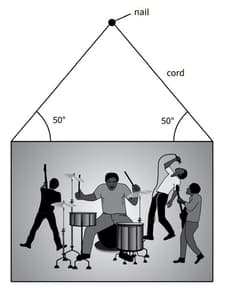David Sang and Graham Jones Solutions for Chapter: Forces: Vectors and Moments, Exercise 8: EXAM-STYLE QUESTIONS
David Sang Physics Solutions for Exercise - David Sang and Graham Jones Solutions for Chapter: Forces: Vectors and Moments, Exercise 8: EXAM-STYLE QUESTIONS
Attempt the free practice questions on Chapter 4: Forces: Vectors and Moments, Exercise 8: EXAM-STYLE QUESTIONS with hints and solutions to strengthen your understanding. Physics for Cambridge International AS & A Level Coursebook 3rd Edition Digital Access solutions are prepared by Experienced Embibe Experts.
Questions from David Sang and Graham Jones Solutions for Chapter: Forces: Vectors and Moments, Exercise 8: EXAM-STYLE QUESTIONS with Hints & Solutions
A metal rod of length has a disc of radius fixed rigidly at its centre, as shown. The assembly is pivoted at its centre.
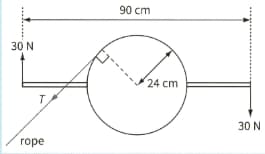
Two forces, each of magnitude , are applied normal to the rod at each end to produce a turning effect on the rod. A rope is attached to the edge of the disc to prevent rotation. Calculate:
The torque of the couple produced by the forces
A metal rod of length has a disc of radius fixed rigidly at its centre, as shown. The assembly is pivoted at its centre.
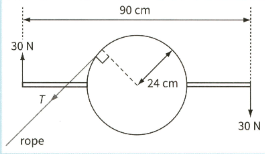
Two forces, each of magnitude , are applied normal to the rod at each end so as to produce a turning effect on the rod. A rope is attached to the edge of the disc to prevent rotation. Calculate:
The tension in the rope.
State what is meant by the torque of a couple.
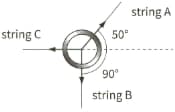
Three strings, , are attached to a circular ring, as shown in Figure . The strings and the ring all lie on a smooth horizontal surface and are at rest. The tension in string is . Calculate the tension in strings .
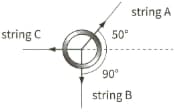
This diagram shows a picture hanging symmetrically by two cords from a nail fixed to a wall. The picture is in equilibrium.

Explain what is meant by equilibrium.
This diagram shows a picture hanging symmetrically by two cords from a nail fixed to a wall. The picture is in equilibrium.
Draw a vector diagram to represent the three forces acting on the picture in the vertical plane. Label each force clearly with its name and show the direction of each force with an arrow.
This diagram shows a picture hanging symmetrically by two cords from a nail fixed to a wall. The picture is in equilibrium.
The tension in the cord is and the angle that each. End of the cord makes with the horizontal is Calculate:
The vertical component of the tension in the cord
This diagram shows a picture hanging symmetrically by two cords from a nail fixed to a wall. The picture is in equilibrium.
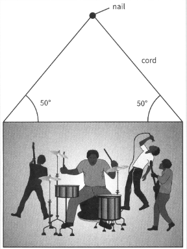
The tension in the cord is and the angle that each. End of the cord makes with the horizontal is Calculate:
The weight of the picture.


